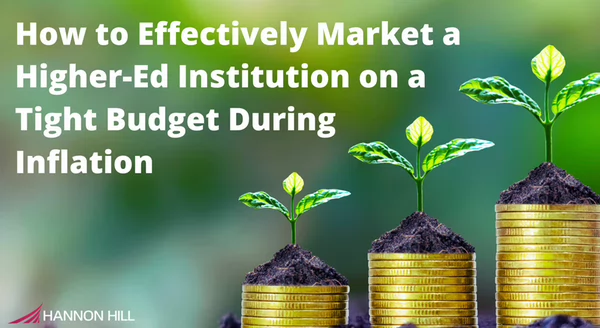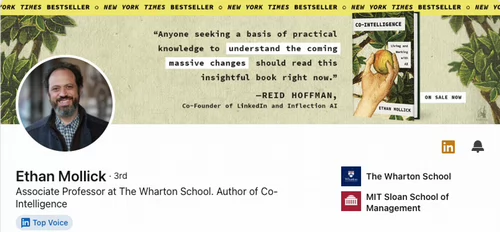
Marketing a college or university is a complex task. It becomes even more challenging when budget constraints are involved.
In the current economy, many higher education institutions are experiencing financial challenges, making it difficult to sustain their operations.
The president of the University of Saint Katherine recently attributed "extraordinary inflation" to the school's shutdown this spring.
This article provides practical solutions for effectively marketing a higher-ed institution, even on a tight budget.
The current economic landscape significantly impacts higher education institutions and their ability to market themselves.
It's crucial to understand these economic influences to plan effectively.
Higher-ed marketers should anticipate changes and adjust their marketing strategies by staying informed about financial trends and fostering open communication with the department in charge of the overall budget.
This proactive approach can help you optimize your funding and ensure the best use of your resources.
Budget constraints are a common challenge in education, particularly for small schools.
These constraints can stem from various sources, such as reduced endowments, increased operational and soaring labor costs to retain talent, or decreased tuition revenue.
Identifying these constraints is the first step towards managing them.
Below are some strategies to overcome budget constraints:
Strategic planning is essential, especially when resources are limited.
It involves setting clear objectives, identifying cost-effective strategies, and allocating resources wisely.
It ensures that every dollar spent contributes to achieving your institution's goals. The more you attribute your efforts to increased revenue, the better your chances are of maintaining your budget.
Remember, a well-planned marketing strategy can yield significant results, even on a shoestring budget.
It's all about making the most of what you have. This might involve leveraging digital marketing tools, utilizing social media platforms, or engaging alumni networks.
With careful planning, you can overcome budget constraints and effectively market your higher education institution.
Digital marketing, enhanced by artificial intelligence (AI), emerges as a highly cost-effective solution.
Google's AI-powered search ads help users show the most relevant ad for every user search at the right price, reducing waste by increasing efficiency.
ChatGPT, combined with search engine optimization tools such as SEMRush, Answer the Public, or Google Search Console, helps marketers create SEO-optimized, high-intent keyword headlines, metadata descriptions, and content.
Email marketing tools like Mailchimp use data science and predictive analytics to determine when contacts will most likely engage with your emails.
Embracing AI-powered digital marketing is a smart move for any higher-ed institution operating with a small staff on a shoestring budget.
Social media platforms are a goldmine for higher-ed marketing. They allow marketers to interact with prospects in real-time, gather feedback, and build strong relationships with their audiences.
User-generated content works best due to its authentic and organic nature.
Statistics show that nearly:
"80% of people say UGC highly impacts their purchasing decisions."
Higher-ed marketers can build a strong brand presence and attract potential students by creating engaging social media content and fostering online communities.
Targeting and personalization are key to maximizing the efficiency of your marketing budget.
By understanding your audience and tailoring your messages to their interests and needs, you can increase engagement and conversion rates on your most important digital asset -- your website.
According to McKinsey & Company:
71% of modern online shoppers appreciate and expect personalization, while 76% are frustrated when they don't receive recommendations that relate to them.
Personalized content resonates with prospective students, making them feel valued and understood.
This approach not only improves the effectiveness of your marketing efforts but also enhances the overall student experience.
Click the banner below to learn how Clive, by Hannon Hill, can help you tailor your content to increase student engagement.
Content marketing is a cost-effective way to establish your institution as a thought leader in the education sector.
Colleges and universities are filled with academic thought leaders, making them uniquely positioned to create and share valuable content that attracts and engages prospective students, parents, and other stakeholders.
Ethan Mollick, for example, an associate professor at The Wharton School of the University of Pennsylvania, established himself as a thought leader in his quest to democratize business education through AI applications.

Implementing an expert search or media search feature on your website is a great way to get your subject matter experts in front of the media and gain free exposure.
Leveraging the expertise of your faculty and staff can build your institution's reputation and drive organic traffic to your website.
Focusing on topics relevant to your audience and optimizing your content for search engines can increase visibility and reach without a significant investment.
This strategy enhances your institution's credibility and showcases your academic community's thought leadership, solidifying your place at the forefront of higher education.
Alumni networks are a valuable resource for higher education marketers.
Engaging alumni in your marketing efforts through spotlights can help spread the word about your institution and its offerings.
Word-of-mouth marketing, facilitated by alumni, is a powerful tool. It's not only cost-effective but also highly credible social proof.
Encourage your alumni to share their experiences and success stories to attract prospective students.
Collaborative partnerships and content curation are powerful strategies for reducing marketing costs and enhancing your institution's reach and influence.
By teaming up with other institutions or businesses, you can pool resources and extend your audience reach.
Consider partnering with local businesses for events or sponsorships or collaborating with other educational institutions on joint marketing campaigns.
These partnerships save money and also foster a sense of community and mutual support.
Additionally, content curation can significantly reduce the time and cost required to create original content.
By sharing valuable content from other thought leaders and organizations, you can strengthen relationships within your industry and provide diverse perspectives to your audience.
This approach enhances your content strategy, builds trust, and positions your institution as a hub of insightful and relevant information.
Watch the video below from a recent episode of the Education Marketing Leader podcast on the benefits of content curation:
It's vital to measure and analyze your marketing efforts to ensure the best use of your limited marketing budget.
This involves tracking key performance indicators and using analytics tools to understand what's working and what's not.
By regularly reviewing your marketing performance, you can identify areas for improvement and make data-driven decisions.
This will help you optimize your marketing strategies and ensure that every dollar spent contributes to your institution's goals.
Marketing a higher-ed institution on a shoestring budget requires strategic planning, creativity, and adaptability.
Prioritize initiatives that align with your institution's goals and be ready to adapt your strategies as needed.
Remember, a constrained budget doesn't mean constrained potential. Embracing change and innovation is paramount, especially in a rapidly evolving landscape.
Beware of the most dangerous phrase in business:
“We've Always Done It This Way."
Sticking to outdated methods can hinder your progress and limit your institution's growth.
With the right approach and a willingness to evolve, you can achieve great results and make a significant impact, regardless of budget limitations.
Complete the form below to schedule a personalized discovery call today. Learn how Cascade CMS and Clive can optimize your higher-ed marketing strategies and stretch your budget.
Last Updated: Jul 2, 2024 11:00 AM